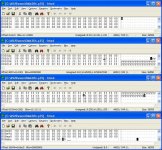I'll have a look at speedstor, I didn't know it works with SCSI drives.
I've been testing the drive in a more modern system with linux and I can't find any issues with it. BTW the constant flashing LED is a "heartbeat LED" (if it works like the Elite 3). I've been trying to use the sg_utils to see if there is anything odd about the drive. One thing I don't seem to be able to do is set the write caching:
sginfo -c -6 /dev/sdb
Code:
Caching mode page (0x8)
-----------------------
Initiator Control 1
ABPF 0
CAP 0
DISC 1
SIZE 0
Write Cache Enabled 0 <------
MF 0
Read Cache Disabled 0
Demand Read Retention Priority 0
Demand Write Retention Priority 0
Disable Pre-fetch Transfer Length 0
Minimum Pre-fetch 0
Maximum Pre-fetch 96
Maximum Pre-fetch Ceiling 0
FSW 0
LBCSS 0
DRA 0
NV_DIS 0
Number of Cache Segments 4
Cache Segment size 0
Non-Cache Segment size 0
The output of:
sdparm -6 -a /dev/sdb
WCE 0 [cha: n, def: 0, sav: 0]
Indicates that write caching cannot be enabled, so I guess it's just a read cache.
I tried setting the RCD (Read Cache Disabled) to 1 and saving it:
sdparm -6 -a /dev/sdb
RCD 1 [cha: y, def: 0, sav: 1]
Setup the drive in the 486 system and still get the same problem.
I can't figure why this controller wont work with this drive. Controller works with other drives, drive works with other controllers. Both are 5MB/s SCSI-2.
Does anyone know what could be causing the incompatibility?

